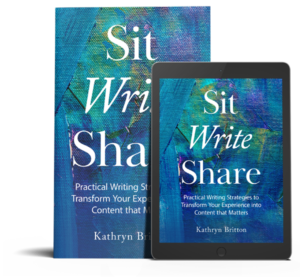When people want to increase their rates of progress, they tend to focus on applying more force: Work longer. Pedal faster. Kick harder. Press harder on the accelerator. But it also helps to reduce friction: Remove obstacles. Add wheels to a suitcase. Streamline shape. What would happen if instead of just trying to work harder at writing, we made the job easier by reducing writing friction?
Here are some obstacles to writing: feeling overwhelmed, perfectionism, getting distracted, loneliness, insecurity about product shape. Read on for some brief coaching that can help you reduce the friction from these obstacles.
Remove Resistance Rather than Apply More Force
I got this idea from Loran Nordgran, guest on the Hidden Brain podcast. He explained that people tend to think the best way to achieve a goal is to apply more force, while it is often better to remove invisible obstacles. The book he co-authored with David Schonthal, The Human Element: Overcoming the Resistance That Awaits New Ideas probably belongs on most of the bookshelves of people who want to make a difference with their writing.
Story about Removing Friction
Nordgran told a purely wonderful story about a company with a new way to design custom furniture, providing people with design tools to create couches that exactly suited them. I could imagine the couch my husband and I would design together: highbacked with just enough room for us each to have our own space but still touch each other. Potential customers loved the idea and were using the tool. But the company wasn’t closing sales. Should they apply more force, for example by adding design elements, lowering prices, or increasing advertising investment? With the authors’ help, they found that the obstacle to purchase was that people worried about what to do with the old couch when the new one arrived. That was just troublesome enough that people hesitated to place orders. When the company offered to take the old couch away when delivering the new one, sales soared.
Reducing Writing Friction
I am assuming your reason for reading this article is that you want to get more writing done. Perhaps you feel like you have a book in you. You might even already have committed to getting a book written. Perhaps you want to write a blog that shows off your expertise. Maybe getting that thesis done is all that stands between you and your degree. When I was at IBM, people had to get patents to get promoted past a certain level. Often the main difficulty was getting invention disclosures written about the novel ideas they had already had.
Instead of forcing yourself to spend more time writing, what if you thought about the obstacles that keep the time you do spend from being productive?
Nine Obstacles and Ways to Reduce Their Friction
Pretend you and I are working together to help you get a writing project done. Here are things you might say, and the answers I (KHB) might give you.
Feeling Overwhelmed
You: “When I sit down to write, I can’t think of anything to say. I end up doodling or looking at Instagram.”
KHB: Try planning ahead at the end of each session for the next session, listing one or two items that would move you forward. Then when you sit down cold to a new session, you get the benefit of ideas that occurred when you were fully warmed up in the previous session. (This is Write Experiment 16 in my book, Sit Write Share.) You might also try writing about what it feels like not to be able to write right now. Sometimes that can start the words flowing (This is Write Experiment 10.)
You: “I get overwhelmed by the sheer size and complexity of my planned product. It feels like climbing a mountain.”
KHB: Narrow your focus in a particular session. Make a list of elements of the whole product. For my kind of writing, I have three lists: concepts I want to explain, stories I want to tell, and activities I want people to do. When I sit down to write, I pick one item from the list and focus on completing it. When you are making a list, give yourself credit for getting writing done. The list itself is a writing product, even if nobody else ever sees it.
You: “I have identified the major elements that I want to address in my writing, but each one still seems like a mammoth task.”
KHB: This might be good place to look for a repeatable structure that you can apply in each major element. Notice the way this article has a repeated Question/Answer structure. Even if you’re writing chapters that are many pages of unbroken prose, you can still have an underlying structure that you repeat, such as an opening statement about the topic, story demonstrating its importance, explanations of key concepts, story showing some of the concepts in action, closing summary. This structure may or may not show up to your readers as subheadings, but it helps you break down the challenge into more manageable chunks. (This is Write Experiment 12.)
Perfectionism
You: “When I’m writing, I erase almost as many words as I write. I feel like I’m putting in a tremendous amount of energy and getting nothing from it.”
KHB: This sounds like you’re trying to draft and edit at the same time. If you separate these processes, your energy goes a lot further. Decide when you sit down to write whether you’re going to draft something new or edit something already started. If drafting, the only thing you need to accomplish is getting a shitty first draft that at least mostly captures the item you chose from your list of writing items. The sentences can be clunky, the beginning lame, transitions non-existent, and the ending vague. It doesn’t matter. You have something that can be polished in a session in which you choose to edit. Then you can worry about the overall shape, the choice of the right words, the music of your language. (This is Write Experiment 8).
Distractions
You: “I write on my computer, but there are so many tempting distractions there.”
KHB: Why not use those distractions as rewards for time spent with whatever writing activity you’ve chosen. I just took a break from writing this to play one round of a game that I enjoy. That gave my brain a brief rest from thinking about this topic. Now I’ve set a timer to work for 30 more minutes before I allow myself to play again. It can also be a good time to try co-working with someone else who needs to get writing done. Being afraid that the other person will see you stray into only eye candy might keep you focused. (This is Share Experiment 4.)
You: “When I start to write, I get distracted by all kinds of critical voices in my head.”
KHB: Acknowledge the voices as part of the reality of your past life, and then open your mind to a different future reality. This is a good time to exercise self-compassion. You can find more ideas for changing self-talk in my recent article, Vulnerability Supports Creativity.
Loneliness
You: “Writing feels so lonely. I work better when I’m bouncing ideas off other people.”
KHB: Writing doesn’t have to be a completely solo exercise. Try out ideas on a friend. Create a writing circle that looks at your drafts and gives feedback. You can even, with a good agreement in place, have a rewarding experience with a co-author. Get together to hash out structure and who does what, separate to draft different sections, get back together to show your work (Having a co-author is the subject of Share Experiment 5).
You: “I am working on an academic document, and I am not getting any guidance. I feel like I’m going in circles.”
KHB: Sometimes you just have to set your own direction, create a strawman, and get reactions later. If that is difficult to do on your own, try finding a writing coach or a fellow student who is facing the same obstacle. You can talk through possibilities, get intermediate feedback, and have someone who cares about you being productive.
Insecurity About Product Shape
You: “I want to write [a proposal] [a brochure] [an op-ed] [a job application letter]. I know there must be a right way to do it, and I really don’t want to invest my creativity reinventing the wheel. ”
KHB: You could do an internet search for a template. One writer wanted to write her first op-ed and found numerous templates by googling “op-ed template.” This might also be a good place to use ChatGPT or one of the other AI writing tools that have been taking the writing world by storm. Why waste your own creativity inventing something that has already been invented? You can treat ChatGPT as your reasonably competent assistant. Give it clear instructions and then use what it produces as a starting point.
Conclusion
Many of the experiments in Sit Write Share concern ways to reduce friction to make writing easier and more enjoyable. The ideas above are just a sample. The free workbook that accompanies the book is available on the book’s website, sitwriteshare.com. The workbook will help you take stock of your writing practice right now, acknowledge the force you are already applying well, and identify places to reduce resistance.

